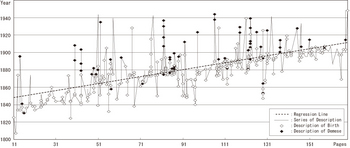Telling a History 03 – Unconscious Description [Column_Tracksides]
 : spur abandoned in 1986. Osaka To-ko, Osaka, Japan. 1986
: spur abandoned in 1986. Osaka To-ko, Osaka, Japan. 1986Here, I’m considering the characteristics of the history regarding our hobby.
If we can recognize the descriptions of retirements or abandonments as unconscious descriptions, we can recognize that a historian describes the retirements or abandonments to reduce his/her mental load. Let’s see whether these descriptions are consciously or unconsciously written, through an example I found.
British historian Hamilton Ellis represents the development of British passenger equipment as a 176 pages book “NINETEENTH CENTURY RAILWAY CARRIAGES” (Modern Transport Publishing Co., 1949). Here, he represents the development by describing the beginnings of new equipment in chronological order. Accordingly, dates appear in the book roughly grow every other page, alike standard histories.
 : line graph showing the series of dates appear in Ellis’ book
: line graph showing the series of dates appear in Ellis’ bookWhereas, the series of dates in his book occasionally jump up and down by the retired dates of equipment which he repeatedly inserts in his history. These descriptions of demise seem to disturb the overall flow. That is, these descriptions are meaningless in explaining the development of equipment: they can be caught as senseless descriptions.
According to the dictionary of psychoanalysis, an unconscious is a mental place of intellect made of senseless citation of letters. His descriptions of demise can be recognized as the senseless citation of letters. Therefore, these descriptions can be caught as unconsciously reproduced wounds. Freud’s theory of repetition tells us that unconsciously reproduced wounds reduce the mental load. That is to say, Ellis unconsciously describes the demise repeatedly to heal his mind.
鉄道趣味の世界における歴史の記述についての話題である。
先に、歴史の記述者は、無意識のうちに対象の消滅をその記述の中で繰り返すことによって、喪失感を癒していると記した。その実例を挙げる。挙げるのはイギリスの歴史家であり、かつ趣味人であるHamilton Ellis(1908〜1987)による歴史書「NINETEENTH CENTURY RAILWAY CARRIAGES」(1949)である。本書はたまたま手元にあったもので、特異なものではないと思う。
Ellisは、イギリスにおける客車の発展を、ボギー車や解放客室の登場といった事物の創始事例を時系列に沿って挙げ説明する。したがって、本文中に記される年代を順に拾いグラフにすると、本文の記述は概ね右肩上がりの折れ線で表される。発展史としてはごく普通だ。しかし、この折れ線は、本文中に何度となく記される廃車などの年代により、とてもぎくしゃくしたものとなっている。
そもそも、客車の発展を記す中で、廃車年代といった終焉事例はこの発展史の論旨になじまない。あえていえば、意味を欠いた記述である。
一方、無意識とは「それ自体としては意味を欠いた文字の素材によって構成される知の場所」(出典:新版精神分析事典、弘文堂)として定義される。つまり、客車の発展を記す歴史において、事物の終焉事例をめぐる記述は無意識的な記述だといえる。
フロイトによれば、心の傷は無意識のうちに悪夢を反復することで癒される。したがって、Ellisによって反復される事物の終焉事例をめぐる記述は、彼の心の負荷を軽減するためにあるといえる。
2014-10-03 09:00
コメント(0)




コメント 0